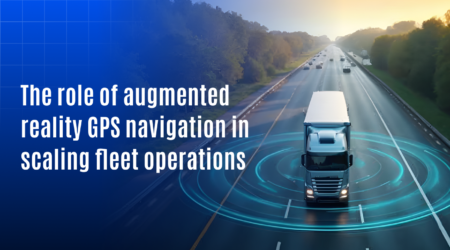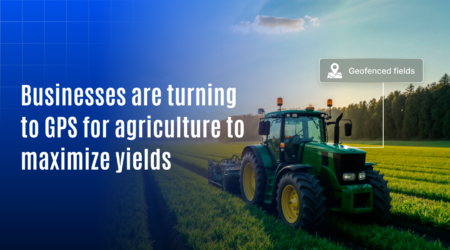Why AI Based GPS Navigation Is the Future of Logistics

The global logistics industry is growing at an unprecedented pace, with the market expected to reach USD 14.08 trillion by 2028. But rapid growth brings new demands from delivering faster and cutting costs to reducing operational risks and keeping customers informed in real time. In this high-stakes environment, traditional GPS navigation are quickly becoming outdated.
Many logistics operations still rely on basic navigation tools that offer static routing and delayed updates. This often leads to missed delivery windows, rising fuel expenses, and inefficient resource planning challenges modern logistics businesses can no longer afford to ignore.
That’s where Artificial intelligence-based GPS navigation is changing the game.
Unlike conventional systems, AI-powered GPS tools do more than map a route. They learn from traffic patterns, analyze real-time conditions, and make smart decisions to keep deliveries on track and fleets running efficiently. These systems adapt to live traffic, weather changes, driver behavior, and delivery urgency all while helping you operate leaner and smarter.
If your logistics operation is still running on outdated tech, it’s time to rethink your strategy. This blog explores why AI-based GPS navigation is the future of logistics, and how it can help your business gain a competitive edge in 2025 and beyond.
What is AI-based GPS navigation?
AI-based gps navigation is an advanced system that uses artificial intelligence, machine learning, and real-time data to improve routing and decision-making. It learns from past routes, analyzes live conditions, and adjusts instantly.
Unlike traditional GPS that relies on static routes, AI systems dynamically adapt to:
- Traffic congestion
- Roadblocks and accidents
- Weather conditions
- Driver behavior
- Delivery priority
This makes them ideal for logistics companies managing multiple deliveries, vehicles, and regions.
Why Traditional GPS Falls Short
Before diving into the benefits, it’s important to understand the limitations of legacy GPS tools.
Key drawbacks:
- Offers only shortest-distance routing, not fastest or most fuel-efficient
- Can’t react to real-time changes like traffic jams or road closures
- Provides no insight into driver behavior or vehicle health
- Lacks predictive capabilities it reacts late instead of planning ahead
In logistics, these limitations lead to delays, higher fuel costs, missed ETAs, and frustrated customers.
Why AI based GPS navigation is a game changer for logistics
Let’s break down how AI is revolutionizing logistics operations:
1. Smarter route optimization
AI-powered navigation continuously analyzes traffic, road conditions, and vehicle data to choose the most efficient route, not just the shortest.
- Minimizes travel time and idle hours
- Considers road closures and accidents
- Adapts to weather or environmental risks
2. Real-time rerouting
If there’s a sudden delay ahead, AI adjusts the route instantly.
- Reduces delivery disruptions
- Helps meet narrow time windows
- Avoids penalties or SLA breaches
3. Fuel and cost efficiency
Fleets using AI-based routing often see major savings.
- Fewer detours = less fuel burned
- Smart route grouping = more deliveries per trip
- Predictive maintenance = fewer breakdowns
4. Better driver and asset management
AI tracks driver behavior such as speeding, harsh braking, or unnecessary idling.
- Helps plan safe and efficient trips
- Reduces wear and tear on vehicles
- Improves fleet safety scores
5. Improved customer experience
Your clients care about timely deliveries and clear tracking.
- Real-time ETAs
- Automated updates
- Fewer missed or late deliveries
6. Data-driven decision making
AI tools generate detailed reports on route performance, driver behavior, fuel use, and delivery success.
- Helps managers plan better
- Identifies problem areas
- Informs training and cost-saving strategies
Real-world logistics use cases
Cold-chain transport
AI GPS ensures timely delivery of temperature-sensitive goods by avoiding traffic and prioritizing quick routes.
E-commerce last mile
Predictive AI navigation reduces delivery failures and ensures packages arrive on time even in dense city zones.
Emergency logistics
AI calculates fastest safe routes in real-time during crises like floods, strikes, or traffic blackouts.
Common myths about AI in navigation
Let’s bust a few:
- Myth: It’s too expensive.
Reality: The ROI from fuel savings, faster deliveries, and fewer errors outweighs the investment.
- Myth: AI is hard to manage.
Reality: Most platforms are built for usability with dashboards and mobile apps.
- Myth: It replaces humans.
Reality: AI supports drivers and managers, it doesn’t replace them.
What to look for in an AI-powered GPS navigation system
Not all AI navigation tools are created equal. Before investing, check for:
- Real-time traffic and weather data
- Machine learning-based route suggestions
- Driver behavior tracking
- Mobile app for on-the-go access
- Integration with existing fleet management or dispatch software
- Scalable platform with custom alerts and reports
Future trends in AI-based GPS navigation
AI-based GPS navigation is just getting started.
In the next 3–5 years, expect:
Summary: smarter navigation, smarter logistics
AI-based GPS navigation isn’t a luxury, it’s becoming a logistics necessity.
To recap, it helps businesses:
- Make smarter, faster decisions
- Cut fuel and operational costs
- Improve delivery performance
- Keep customers happy
Stay competitive in a fast-moving market





